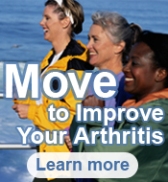Spotlight
No Leisure-time Physical Activity in Adults with Arthritis
Arthritis contributes to physical inactivity in the general population. Despite arthritis specific barriers to being physically active there are targeted interventions available to benefit adults with arthritis.

The prevalence of no leisure-time physical activity (LTPA) is much higher among adults with arthritis than those without arthritis, and exceeds ≥30% in 23 states. Efforts to increase physical activity levels in the general population must address the large number of adults with arthritis to be successful.
There is strong evidence that physical activity reduces pain, improves function and mood, and delays disability in adults with arthritis. Despite these known benefits of physical activity for managing arthritis, the majority (30%–50%) of adults with arthritis are physically inactive. Arthritis patients have disease-specific barriers to being physically active including episodic pain, fear of making their arthritis worse, lack of knowledge about the best type and amount of exercise, and fear of injury. These barriers can be addressed via targeted health communication campaigns, access to community-based exercise programs proven to be safe and effective for arthritis, and attention to policy and environmental strategies that may benefit adults with arthritis.
The CDC Arthritis Program has developed and evaluated two health communications campaigns centered on messages to increase physical activity among adults with arthritis. Physical Activity. The Arthritis Pain Reliever is an English-language campaign and Buenos Dias Arthritis targets Spanish-speaking adults with arthritis. Both campaigns have been shown to reach the intended audience, increase knowledge about physical activity, and increase initiation of physical activity. All campaign materials are free, updated regularly, and customizable.
Group exercise and behavioral change programs can help adults with arthritis become physically active by offering a safe and effective environment to exercise. These programs also provide social support, which is an important factor to increase physical activity among people with arthritis. CDC recommends six physical activity programs for adults with arthritis. These programs are offered in local communities through agencies such as senior centers, Area Agencies on Aging, YMCA’s, churches, parks and recreation departments, and agricultural extension offices among others.

Reference:
Hootman JM, Barbour KE, Watson KB, Harris C. State-specific prevalence of no leisure-time physical activity among adults with and without doctor-diagnosed arthritis—United States, 2009. MMWR. 2011; 60(48):1641-1645. html pdf [1.10MB]
More Information
Get email updates
To receive email updates about this page, enter your email address:

Contact Us:
- Arthritis Program
Mailstop K-51
4770 Buford Hwy NE
Atlanta, GA 30341-3724
- Phone: 770.488.5464
Fax: 770.488.5964 - cdcinfo@cdc.gov


